Lady Justice
Lady Justice (Latin: Iustitia) is an allegorical personification of the moral force in judicial systems.[1][2] Her attributes are a blindfold, a balance, and a sword. She often appears as a pair with Prudentia, who holds a mirror and a snake.
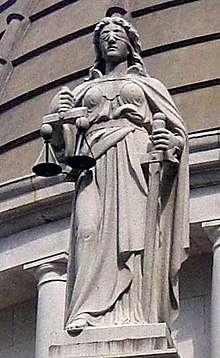
Lady Justice originates from the personification of Justice in Ancient Roman art known as Iustitia or Justitia after Latin: Iustitia,[3] who is equivalent to the Greek goddesses Themis and Dike.
The goddess Iustitia
The origin of Lady Justice was Iustitia, the goddess of Justice within Roman mythology. Iustitia was introduced by emperor Augustus, and was thus not a very old deity in the Roman pantheon.
Justice was one of the virtues celebrated by emperor Augustus in his clipeus virtutis, and a temple of Iustitia was established in Rome on 8 January 13 BC by emperor Tiberius.[3] Iustitia became a symbol for the virtue of justice with which every emperor wished to associate his regime; emperor Vespasian minted coins with the image of the goddess seated on a throne called Iustitia Augusta, and many emperors after him used the image of the goddess to proclaim themselves protectors of justice.[3]
Though formally called a goddess with her own temple and cult shrine in Rome, it appears that she was from the onset viewed more as an artistic symbolic personification rather than as an actual deity with religious significance.
Depiction

The personification of justice balancing the scales dates back to the goddess Maat,[4] and later Isis, of ancient Egypt. The Hellenic deities Themis and Dike were later goddesses of justice. Themis was the embodiment of divine order, law, and custom, in her aspect as the personification of the divine rightness of law.
Scales
Lady Justice is most often depicted with a set of scales typically suspended from one hand, upon which she measures the strengths of a case's support and opposition.
The Greek goddess Dike is depicted holding a set of scales.
Bacchylides, Fragment 5 (trans. Campbell, Vol. Greek Lyric IV) (Greek lyric c. 5th B.C.):
If some god had been holding level the balance of Dike (Justice).
The scales represent the weighing of evidence, and the scales lack a foundation in order to signify that evidence should stand on its own.
Blindfold

Since the 16th century, Lady Justice has often been depicted wearing a blindfold. The blindfold represents impartiality, the ideal that justice should be applied without regard to wealth, power, or other status. The earliest Roman coins depicted Justitia with the sword in one hand and the scale in the other, but with her eyes uncovered.[5] Justitia was only commonly represented as "blind" since the middle of the 16th century. The first known representation of blind Justice is Hans Gieng's 1543 statue on the Gerechtigkeitsbrunnen (Fountain of Justice) in Berne.[6]
Instead of using the Janus approach, many sculptures simply leave out the blindfold altogether. For example, atop the Old Bailey courthouse in London, a statue of Lady Justice stands without a blindfold;[7] the courthouse brochures explain that this is because Lady Justice was originally not blindfolded, and because her "maidenly form" is supposed to guarantee her impartiality which renders the blindfold redundant.[8] Another variation is to depict a blindfolded Lady Justice as a human scale, weighing competing claims in each hand. An example of this can be seen at the Shelby County Courthouse in Memphis, Tennessee.[9]
Earlier representations of a blindfolded woman began appearing in 13th century, Europe. As part of the duo "Ecclesia et Synagoga" the blindfolded Synagoga adorned Gothic cathedrals as architectural sculpture and can be found in illustrations of religious manuscripts from that period. This iconography of the blindfolded woman was emphasized when Synagoga's blindfold occasionally was depicted as a coiled serpent. Another early representation of a blindfolded woman is found in a 14th-century prayer book where a blindfolded woman, Torah, is shown with her spouse.
Sword
The sword represented authority in ancient times, and conveys the idea that justice can be swift and final.[10]
Toga
The Greco-Roman garment symbolizes the status of the philosophical attitude that embodies justice.[10]
In art
- Justice in sculpture
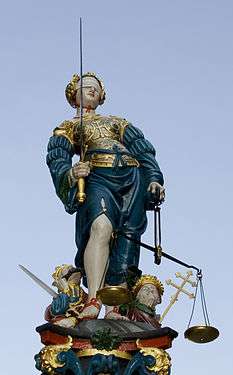 Lady Justice with sword, scales and blindfold on the Gerechtigkeitsbrunnen in Berne, Switzerland—1543
Lady Justice with sword, scales and blindfold on the Gerechtigkeitsbrunnen in Berne, Switzerland—1543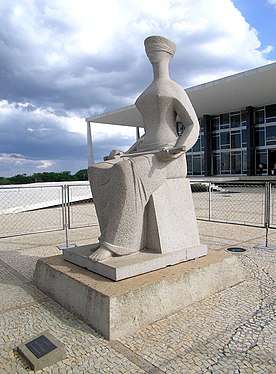 The Justice, in front of the Supreme Court of Brazil
The Justice, in front of the Supreme Court of Brazil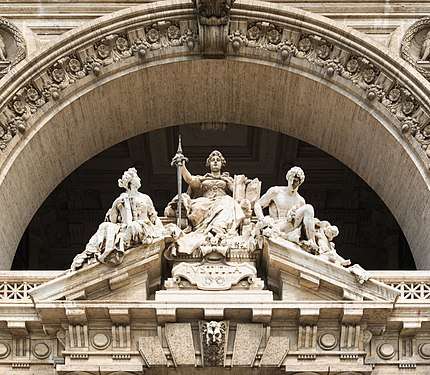 Lady Justice seated at the entrance of The Palace of Justice, Rome, Italy
Lady Justice seated at the entrance of The Palace of Justice, Rome, Italy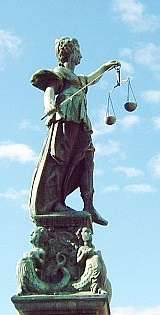 Sculpture of Lady Justice on the Gerechtigkeitsbrunnen (Frankfurt) in Frankfurt, Germany
Sculpture of Lady Justice on the Gerechtigkeitsbrunnen (Frankfurt) in Frankfurt, Germany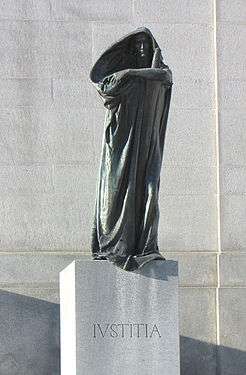
 The Central Criminal Court or Old Bailey, London, UK
The Central Criminal Court or Old Bailey, London, UK Themis, Itojyuku, Shibuya-ku, Japan
Themis, Itojyuku, Shibuya-ku, Japan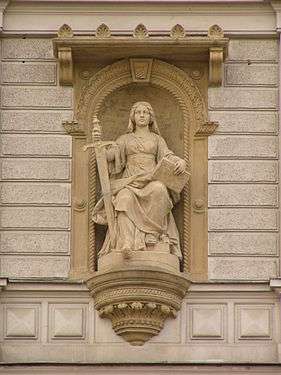 19th-century sculpture of the Power of Law at Olomouc, Czech Republic—lacks the blindfold and scales of Justice, replacing the latter with a book
19th-century sculpture of the Power of Law at Olomouc, Czech Republic—lacks the blindfold and scales of Justice, replacing the latter with a book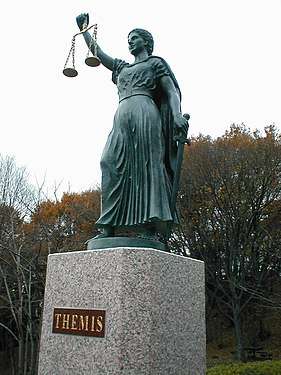 Themis, Chuo University, Tama-shi, Japan
Themis, Chuo University, Tama-shi, Japan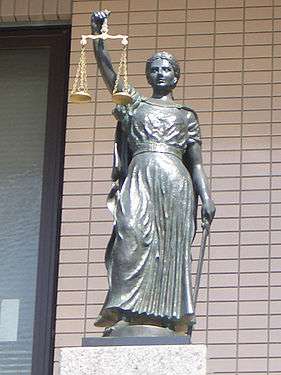 Themis, Chuo University Suginami high school, Suginami-ku, Japan
Themis, Chuo University Suginami high school, Suginami-ku, Japan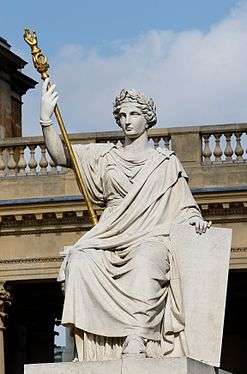 The Law, by Jean Feuchère
The Law, by Jean Feuchère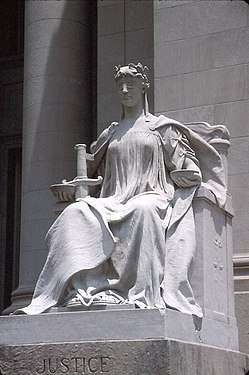 Shelby County Courthouse, Memphis, Tennessee, United States
Shelby County Courthouse, Memphis, Tennessee, United States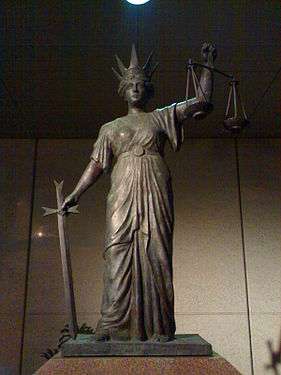
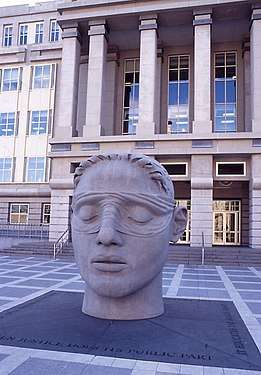
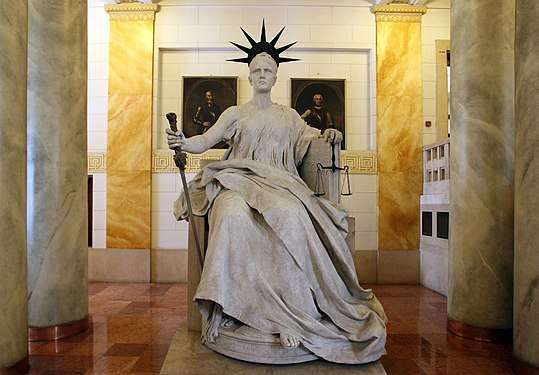 Justitia in the Superior Courts Building in Budapest, Hungary
Justitia in the Superior Courts Building in Budapest, Hungary Themis, Old courthouse, Ghent, Belgium
Themis, Old courthouse, Ghent, Belgium
- Justice in relief
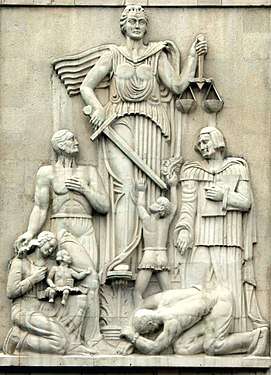
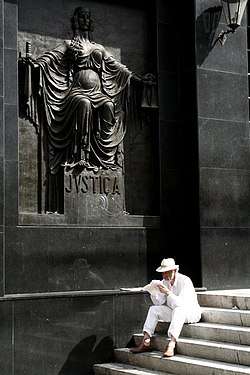
- Justice in painting

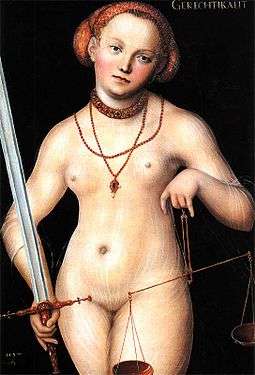 Gerechtigkeit, Lucas Cranach the Elder, 1537
Gerechtigkeit, Lucas Cranach the Elder, 1537 Luca Giordano, Palazzo Medici Riccardi in Florence, 1684–1686
Luca Giordano, Palazzo Medici Riccardi in Florence, 1684–1686_-_1857.jpg) Justitia (Spitzweg), Carl Spitzweg, 1857
Justitia (Spitzweg), Carl Spitzweg, 1857
Lady Justice and her symbols are used in heraldry, especially in the arms of legal government agencies.
- Justice in heraldry
 Justitia in arms of Ilshofen in Baden-Württemberg
Justitia in arms of Ilshofen in Baden-Württemberg Scales and sword in the arms of a Swedish court of law
Scales and sword in the arms of a Swedish court of law Scales balanced on a sword in the arms of Hörby
Scales balanced on a sword in the arms of Hörby Prudentia and Justitia as supporters in the armorial achievement of Landskrona
Prudentia and Justitia as supporters in the armorial achievement of Landskrona
- Justice in numismatics
-%240.50-Fr.1355.jpg) Justice holding scales, $0.50 U.S. fractional currency.
Justice holding scales, $0.50 U.S. fractional currency.
In computer systems
| ⚖ | |
|---|---|
Scales | |
| In Unicode | U+2696 ⚖ SCALES (HTML ⚖) |
| Related | |
| See also | U+00A7 § SECTION SIGN |
There is a symbol has a code point in Unicode at U+2696 that may be used to represent the scales of justice. (For information on how to get this into a document, see Unicode input).
See also
- (Goddesses of Justice): Astraea, Dike, Themis, Prudentia
- (Goddesses of Injustice): Adikia
- (Aspects of Justice):
- (Justice) Themis/Dike/Justitia (Lady Justice), Raguel (the Angel of Justice)
- (Retribution) Nemesis/Rhamnousia/Rhamnusia/Adrasteia/Adrestia/Invidia
- (Redemption) Eleos/Soteria/Clementia, Zadkiel/Zachariel (the Angel of Mercy)
- 5 Astraea, 24 Themis, 99 Dike and 269 Justitia, main belt asteroids all named for Astraea, Themis, Dike and Justitia, Classical goddesses of justice.
- Durga, Hindu goddess of justice
- Lady Luck
- Lady Liberty
- Statue of Liberty
References
- Hamilton, Marci. God vs. the Gavel, page 296 (Cambridge University Press 2005): "The symbol of the judicial system, seen in courtrooms throughout the United States, is blindfolded Lady Justice."
- Fabri, The challenge of change for judicial systems, page 137 (IOS Press 2000): "the judicial system is intended to be apolitical, its symbol being that of a blindfolded Lady Justice holding balanced scales."
- "IUSTITIA". treccani.it.
- "Apendix D: Legal Symbols of the Anglo-American Legal Tradition". The Guide to American Law : Everyone's Legal Encyclopedia. 11. West Publishing Company. St. Paul [Minn.]: West Pub. Co. 1983. p. 687. ISBN 0314732241. OCLC 9196541.CS1 maint: others (link)
- See "The Scales of Justice as Represented in Engravings, Emblems, Reliefs and Sculptures of Early Modern Europe" in G. Lamoine, ed., Images et representations de la justice du XVie au XIXe siècle (Toulouse: University of Toulose-Le Mirail, 1983)" at page 8.
- Image of Lady Justice in Berne.
- Image of Lady Justice in London.
- Colomb, Gregory. Designs on Truth, p. 50 (Penn State Press, 1992).
- Image of Lady Justice in Memphis.
- Brent T. Edwards. "Symbolism of Lady Justice". Retrieved 24 February 2017.
External links
| Wikimedia Commons has media related to Iustitia. |
